This article was medically reviewed by Luba Lee, FNP-BC, MS. Luba Lee, FNP-BC is a Board-Certified Family Nurse Practitioner (FNP) and educator in Tennessee with over a decade of clinical experience. Luba has certifications in Pediatric Advanced Life Support (PALS), Emergency Medicine, Advanced Cardiac Life Support (ACLS), Team Building, and Critical Care Nursing. She received her Master of Science in Nursing (MSN) from the University of Tennessee in 2006.
There are 7 references cited in this article, which can be found at the bottom of the page.
This article has been viewed 28,401 times.
Ulcerative colitis is a type of inflammatory bowel disease, or IBD, that causes chronic inflammation and painful sores (ulcers) in the innermost lining of the large intestine and rectum.[1] The cause of ulcerative colitis is unknown, but there is growing evidence that it is a result of immune system malfunction. Other forms of IBD, as well as different intestinal diseases and conditions can cause similar symptoms to ulcerative colitis, but they often require different treatments. As such, distinguishing between the different types of gastrointestinal problems is important.
Steps
Recognizing the Primary Symptoms of Ulcerative Colitis
-
1Take notice of chronic diarrhea. One of the hallmark signs of ulcerative colitis is chronic diarrhea or having loose stools (poops) on a daily basis. The diarrhea often has pus and blood in it because of the formation of ulcers in the large intestine (colon).
- Between bouts of diarrhea, some bright red blood may also leak from your anus if ulcers are in the rectum, which is the end (distal part) of the large intestine.
- Ulcerative colitis symptoms vary quite a bit among sufferers, from mild to severe, depending on the degree of inflammation and where the ulcers form.
-
2Be alert to an increased urgency to defecate. In addition to diarrhea, ulcerative colitis causes an increased urgency to defecate (poop), so sufferers often feel they can't get too far from a bathroom.[2] The ulcers in the lining of the large intestine affect the ability of the rectum to contract and keep the stool in place longer so water can be absorbed from it.
- As such, diarrhea with ulcerative colitis is loose and watery — dehydration can be a problem in people with severe symptoms. They may require intravenous (IV) fluids from time to time.
- Ulcerative colitis is classified by how much of the large intestine is affected: when the ulcers are limited to the rectum the symptoms tend to be mild; when more of the colon is affected the symptoms tend to be more severe.
Advertisement -
3Be aware of abdominal pain and cramping. Another common symptom of ulcerative colitis is lower abdominal pain and cramping, primarily caused by the ulcers, but also from poor digestion and a disruption in the "good bacteria" in the colon from so much diarrhea. Lower abdominal bloating (distension) and flatulence are also relatively common, depending on a person's diet.
- Avoid spicy foods, high-fiber foods and dairy products because they tend to acerbate the abdominal pain and cramping of ulcerative colitis.
- People who develop ulcerative colitis at a young age (adolescence) are much more likely to have severe symptoms.
-
4Watch for progressive weight loss. People with ulcerative colitis, even milder forms, tend to lose weight unintentionally because of a few different factors: chronic diarrhea, fear of eating and triggering symptoms, and malabsorption of nutrients from their dysfunctional colon.[3] Consequently, weight loss is progressive, especially in adolescents and younger adults, and sometimes to the extent of being dangerous.
- As the body goes into "starvation mode" it initially uses fat stores for energy, then it breaks down muscle and connective tissue into amino acids for energy.
- Ask your doctor about vitamin and mineral supplements, as well as high-calorie foods that don't trigger ulcerative colitis symptoms.
- Eating small meals (five to six daily) tends to promote better digestion instead of two to three larger ones.
-
5Look out for chronic fatigue and tiredness. Due to chronic diarrhea, loss of appetite, weight loss and a lack of essential nutrients, a lack of energy (fatigue) and tiredness during the day are also common signs of ulcerative colitis.[4]
This chronic fatigue and tiredness is not helped by getting lots of sleep at night or taking naps during the day. Muscle weakness may also be seen.- Another factor in the chronic fatigue is anemia — a lack of iron due to blood loss from the ulcers. Iron is needed in the blood (by hemoglobin) to carry oxygen to all the cells in order to make energy.
- Among younger children, ulcerative colitis may delay growth and development due to a lack of energy and nutrients.
-
6Be cautious of less common, albeit widespread symptoms. Less common symptoms of ulcerative colitis include widespread joint pain or soreness (especially in larger joints), red skin rashes around the body, eye irritation and a chronic low-grade fever.[5] When these symptoms are present it's thought that the ulcerative colitis is caused more by an overactive or faulty immune system.
- When a condition is caused by an overactive or faulty immune reaction it's called an autoimmune disease. In essence the body attacks itself and creates lots of inflammation.
- It's not unusual for middle-aged adults with a long history of ulcerative colitis to develop inflammatory arthritis in joints, such as the knees, hands and spine.
Distinguishing Ulcerative Colitis from Similar Conditions
-
1Distinguish between ulcerative colitis and Crohn's disease. Although both are inflammatory bowel diseases, Crohn’s can affect any part of the gastrointestinal tract (both small and large intestines).[6]
Ulcerative colitis is limited to the mucosa and submucosa, the first two layers of the lining of the bowel. Crohn's disease, in addition to the first two layers also involves the next two, the muscular and the connective tissue layers underneath.- Crohn's disease tends to be more serious and symptomatic than ulcerative colitis because its ulcers are deeper and more destructive. Malabsorption of nutrients is more common with Crohn's.
- Crohn's most often develops where the small intestine meets the colon (ileocecal region), so symptoms (pain and cramping) are usually felt higher in the abdomen nearer the stomach.
- Crohn's also causes bloody diarrhea, although the blood is often darker in color because the ulcers are usually further away from the anus.
- Differentiating features include different areas of the colon involved, significant involvement of the small intestine, and granulomas on biopsy. Diarrhea and abdominal pain (especially in the right lower quadrant) are hallmark symptoms.
-
2Don't confuse ulcerative colitis with irritable bowel syndrome (IBS). Irritable bowel syndrome is not an inflammatory disease that leads to ulceration in the intestines.
Instead, it's a disorder that affects the muscle contractions of the large intestine — the contractions are more frequent and rapid, sort of like internal twitches.[7] As such, diarrhea, an increased urge to defecate and lower abdominal cramping is common with IBS also, but there's no blood or pus in the stool.- Diagnosis of IBS is often made by the following criteria: Abdominal discomfort or pain that can be relieved with defecation, associated with change in frequency of stooling, and/or a change in consistency of stool present for at least 12 weeks.
- IBS tends to be less painful because there's no ulcers in the intestinal layers. The cramping pain from IBS is often relieved by a bout of diarrhea.
- IBS tends to be triggered by food and stress mostly, and doesn't have an important genetic component like ulcerative colitis does.
- IBS is far more common in women, whereas inflammatory bowel diseases don't show a gender preference.
-
3Don't mistake ulcerative colitis with lactose intolerance. People with lactose intolerance are unable to properly digest milk sugar (lactose) due to a lack of lactase enzyme.[8] The lactose is then fed upon by intestinal bacteria, which triggers gas production, bloating and diarrhea. The symptoms of lactose intolerance usually begin 30 minutes to two hours after eating or drinking dairy products.
- In contrast, ulcerative colitis develops slowly over time and becomes chronic in most sufferers. It can go into remission, but doesn't go away by avoiding certain foods.
- The diarrhea with lactose intolerance tends to be more explosive because of the gas production, but doesn't contain blood or pus.
- Some nausea is common with lactose intolerance, but fatigue, tiredness and weight loss is not typically experienced.
-
4Learn the difference between ulcerative colitis and intestinal infections. Intestinal infections (either from viruses or bacteria) come on quickly and tend to trigger abdominal pain, cramping and diarrhea, but they don't often last more than a week or so.
Most bacterial infections are caused by food poisoning (Salmonella, E. coli and other species) and also involve forceful vomiting and high fevers, which are not characteristic of ulcerative colitis.[9]- Depending on the species, intestinal infections can lead to blood in the diarrhea if the mucosal lining gets severely irritated, but it doesn't last for much more than a week or so.
- Intestinal infections can happen anywhere in the intestines or stomach, whereas ulcerative colitis is limited to the large intestine.
- Most stomach ulcers are caused by a species of bacteria called H. pylori, which leads to upper abdominal pain, nausea and bleeding. There's no diarrhea and the blood in the feces looks more like coffee grounds.
-
5Know when ulcerative colitis may put you at greater risk of colon cancer. The symptoms of severe ulcerative colitis and colon cancer are very difficult to distinguish from one another.
Both involve lots of pain, bloody diarrhea, fever, weight loss and fatigue; however, ulcerative colitis is more likely to develop into colon cancer when: the entire colon is affected, widespread chronic inflammation is present, and the condition has been active for at least eight years or more.[10]- Men with severe ulcerative colitis are more at risk than women, particularly if they have primary sclerosing cholangitis — a condition that affects the liver.
- People with severe ulcerative colitis should get a colonoscopy exam every one to three years to make sure their condition isn't cancerous.
- Surgery to remove the entire large intestine eliminates the risk of colon cancer.
Getting an Accurate Diagnosis
-
1See a gastroenterologist. Although your family doctor can help rule out some other causes of abdominal pain and chronic diarrhea with blood tests and a stool sample, it's best to get a referral to an intestinal specialist called a gastroenterologist. These specialists will use diagnostic equipment to look directly at the lining of the colon to see if any ulceration is present.
- A blood test can confirm anemia (reduced red blood cells), which infers some sort of internal bleeding due to ulcers of perforation.[11]
- A blood test can also show elevated white blood cells, which indicates some sort of bacterial or viral infection instead.
- A stool sample that shows blood and pus (dead white blood cells) indicates some sort of IBD, whereas lots of bacteria or parasites indicates an infection.
-
2Get a colonoscopy. A colonoscopy allows your gastroenterologist to look at your entire colon by using a thin, flexible tube with a camera attached to the end of it.[12]
The "scope" is inserted into the rectum and takes pictures of the lining of the entire large intestine, so any ulcers are visualized. During the procedure, a small tissue sample (biopsy) can be taken and looked at under a microscope.- As an alternative, a flexible sigmoidoscope can also be used to be visualize the last part of the colon called the sigmoid. Sigmoidoscopy is a better choice over colonoscopy if your large intestine is severely inflamed.
- Scoping the colon can be somewhat uncomfortable, but usually not painful enough to warrant anesthesia or strong pain killers. Lubrication and muscle relaxants are usually enough.
-
3Have other visual diagnostics taken. If your symptoms are severe, your gastroenterologist may take an abdominal x-ray after you've swallowed a thick "barium shake" in order to rule out a perforated colon.[13]
The doctor may also order an abdominal CT scan in order to see how much of the colon is ulcerated and how deep it is. A CT scan is great for distinguishing between ulcerative colitis and Crohn's disease.- Magnetic resonance (MR) enterography is a more sensitive test for finding inflammation and ulceration in the colon and doesn't involve any radiation.
- Chromoendoscopy is used by specialists to rule out colorectal cancer. It involves spraying the inside of the colon with a special dye that highlights cancerous tissue.
References
- ↑ http://www.mayoclinic.org/diseases-conditions/ulcerative-colitis/basics/definition/con-20043763
- ↑ http://www.ccfa.org/what-are-crohns-and-colitis/what-is-ulcerative-colitis/
- ↑ https://www.niddk.nih.gov/health-information/digestive-diseases/ulcerative-colitis
- ↑ https://www.niddk.nih.gov/health-information/digestive-diseases/ulcerative-colitis
- ↑ https://www.niddk.nih.gov/health-information/digestive-diseases/ulcerative-colitis
- ↑ http://www.ccfa.org/what-are-crohns-and-colitis/what-is-ulcerative-colitis/
- ↑ http://www.ccfa.org/what-are-crohns-and-colitis/what-is-ulcerative-colitis/
- ↑ http://www.mayoclinic.org/diseases-conditions/lactose-intolerance/basics/definition/con-20027906
- ↑ http://www.mayoclinic.org/diseases-conditions/food-poisoning/basics/causes/con-20031705
- ↑ http://www.niddk.nih.gov/health-information/health-topics/digestive-diseases/ulcerative-colitis/Pages/facts.aspx#10
- ↑ http://www.mayoclinic.org/diseases-conditions/ulcerative-colitis/basics/tests-diagnosis/con-20043763
- ↑ http://www.mayoclinic.org/diseases-conditions/ulcerative-colitis/basics/tests-diagnosis/con-20043763
- ↑ http://www.mayoclinic.org/diseases-conditions/ulcerative-colitis/basics/tests-diagnosis/con-20043763



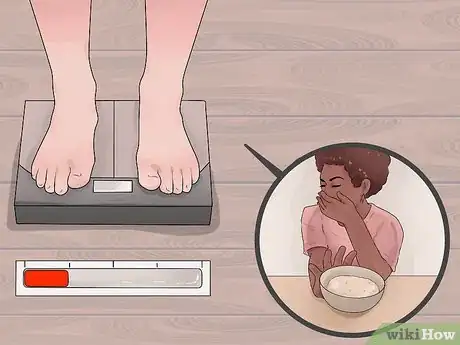

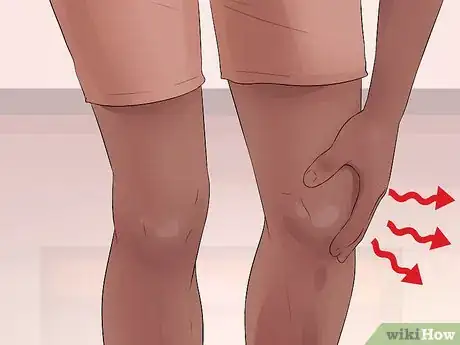



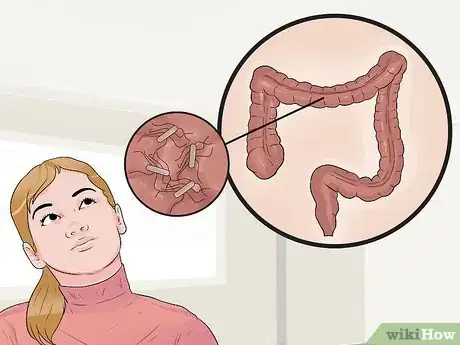
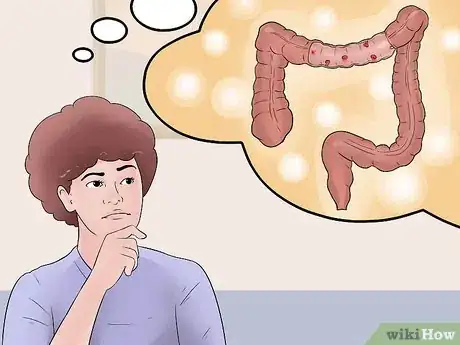
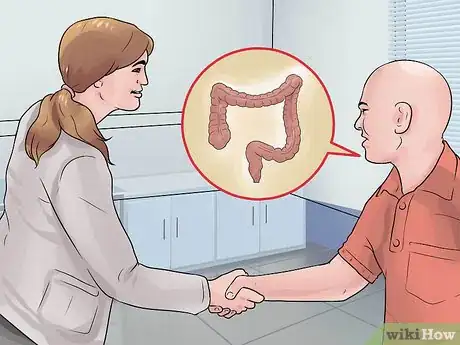
















































Medical Disclaimer
The content of this article is not intended to be a substitute for professional medical advice, examination, diagnosis, or treatment. You should always contact your doctor or other qualified healthcare professional before starting, changing, or stopping any kind of health treatment.
Read More...